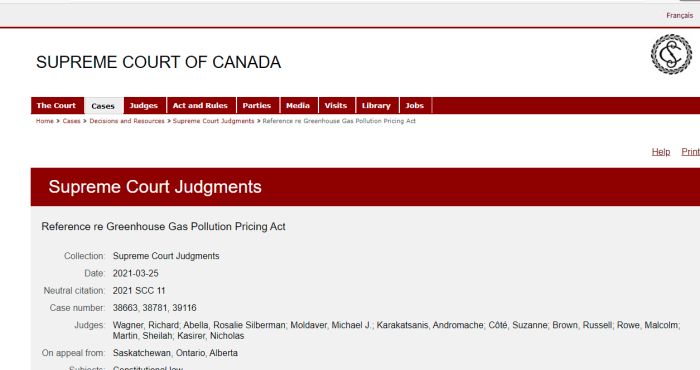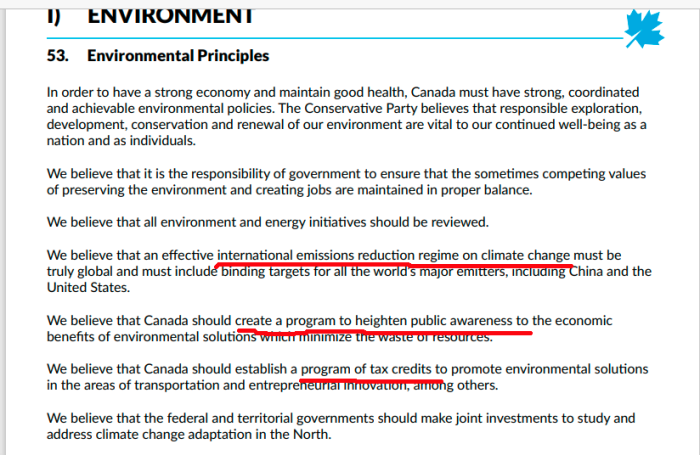
The Supreme Court of Canada, in a 6-3 decision, confirmed that the Carbon tax is constitutional. This is not surprising in the slightest, considering there was no real opposition. All parties parroted the sentiments that climate change was an urgent threat that needed dealt with. In short, they agreed with the underlying facts, so there wasn’t much to argue.
The “resistance”, pictured above, did nothing but orchestrate a dog-and-pony show. It duped plenty of people into convincing them that these politicians were actually fighting.
1. Debunking The Climate Change Scam
The entire climate change industry, (and yes, it is an industry) is a hoax perpetrated by the people in power. See the other articles on the scam, the propaganda machine in action, and some of the court documents in Canada. Carbon taxes are just a small part of the picture, and conservatives are intentionally sabotaging their court cases.
2. The Supreme Court Of Canada Ruling

[7] Global climate change is real, and it is clear that human activities are the primary cause. In simple terms, the combustion of fossil fuels releases greenhouse gases (“GHGs”) into the atmosphere, and those gases trap solar energy from the sun’s incoming radiation in the atmosphere instead of allowing it to escape, thereby warming the planet. Carbon dioxide is the most prevalent and recognizable GHG resulting from human activities. Other common GHGs include methane, nitrous oxide, hydrofluorocarbons, perfluorocarbons, sulfur hexafluoride and nitrogen trifluoride.
[8] At appropriate levels, GHGs are beneficial, keeping temperatures around the world at levels at which humans, animals, plants and marine life can live in balance. And the level of GHGs in the atmosphere has been relatively stable over the last 400,000 years. Since the 1950s, however, the concentrations of GHGs in the atmosphere have increased at an alarming rate, and they continue to rise. As a result, global surface temperatures have already increased by 1.0°C above pre-industrial levels, and that increase is expected to reach 1.5°C by 2040 if the current rate of warming continues.
This appears to be almost cut and paste directly from Ontario’s Factum during their Provincial challenge.
[9] These temperature increases are significant. As a result of the current warming of 1.0°C, the world is already experiencing more extreme weather, rising sea levels and diminishing Arctic sea ice. Should warming reach or exceed 1.5°C, the world could experience even more extreme consequences, including still higher sea levels and greater loss of Arctic sea ice, a 70 percent or greater global decline of coral reefs, the thawing of permafrost, ecosystem fragility and negative effects on human health, including heat-related and ozone-related morbidity and mortality.
[10] The effects of climate change have been and will be particularly severe and devastating in Canada. Temperatures in this country have risen by 1.7°C since 1948, roughly double the global average rate of increase, and are expected to continue to rise faster than that rate. Canada is also expected to continue to be affected by extreme weather events like floods and forest fires, changes in precipitation levels, degradation of soil and water resources, increased frequency and severity of heat waves, sea level rise, and the spread of potentially life-threatening vector-borne diseases like Lyme disease and West Nile virus.
[11] The Canadian Arctic faces a disproportionately high risk from climate change. There, the average temperature has increased at a rate of nearly three times the global average, and that increase is causing significant reductions in sea ice, accelerated permafrost thaw, the loss of glaciers and other ecosystem impacts. Canada’s coastline, the longest in the world, is also being affected disproportionately by climate change, as it experiences changes in relative sea level and rising water temperatures, as well as increased ocean acidity and loss of sea ice and permafrost. Climate change has also had a particularly serious effect on Indigenous peoples, threatening the ability of Indigenous communities in Canada to sustain themselves and maintain their traditional ways of life.
[12] Climate change has three unique characteristics that are worth noting. First, it has no boundaries; the entire country and entire world are experiencing and will continue to experience its effects. Second, the effects of climate change do not have a direct connection to the source of GHG emissions. Provinces and territories with low GHG emissions can experience effects of climate change that are grossly disproportionate to their individual contributions to Canada’s and the world’s total GHG emissions. In 2016, for example, Alberta, Ontario, Quebec, Saskatchewan and British Columbia accounted for approximately 90.5 percent of Canada’s total GHG emissions, while the approximate percentages were 9.1 percent for the other five provinces and 0.4 percent for the territories. Yet the effects of climate change are and will continue to be experienced across Canada, with heightened impacts in the Canadian Arctic, coastal regions and Indigenous territories. Third, no one province, territory or country can address the issue of climate change on its own. Addressing climate change requires collective national and international action. This is because the harmful effects of GHGs are, by their very nature, not confined by borders.
B. Canada’s Efforts to Address Climate Change
.
[13] Canada’s history of international commitments to address climate change began in 1992 with its ratification of the United Nations Framework Convention on Climate Change, U.N. Doc. A/AC.237/18 (Part II)/Add.1, May 15, 1992 (“UNFCCC”). After failing to meet its commitments under multiple UNFCCC agreements, including the Kyoto Protocol, U.N. Doc. FCCC/CP/1997/L.7/Add.1, December 10, 1997, and the Copenhagen Accord, U.N. Doc. FCCC/CP/2009/11/Add.1, December 18, 2009, Canada agreed to the Paris Agreement in 2015. Recognizing that “climate change represents an urgent and potentially irreversible threat to human societies and the planet and thus requires the widest possible cooperation by all countries”, the participating states agreed to hold the global average temperature increase to well below 2.0°C above pre-industrial levels and to pursue efforts to limit that increase to 1.5°C: United Nations, Framework Convention on Climate Change, Report of the Conference of the Parties on its twenty-first session, U.N. Doc. FCCC/CP/2015/10/Add.1, January 29, 2016, at p. 2; Paris Agreement, art. 2(1)(a). Canada ratified the Paris Agreement in 2016, and the agreement entered into force that same year. Canada committed to reducing its GHG emissions by 30 percent below 2005 levels by 2030.
This has been a bipartisan effort, to entangle Canada with more and more UN treaties. Each one erodes more sovereignty.
[14] Under the Paris Agreement, states are free to choose their preferred approaches for meeting their nationally determined contributions. In Canada, the provinces and the federal government agreed to work together in order to meet the country’s international commitments. In March 2016, before Canada had ratified the Paris Agreement, all the First Ministers met in Vancouver and adopted the Vancouver Declaration on clean growth and climate change (“Vancouver Declaration”): Canadian Intergovernmental Conference Secretariat, March 3, 2016 (online). In that declaration, the First Ministers recognized the call in the Paris Agreement for significant reductions in GHG emissions and committed to “[i]mplement[ing] GHG mitigation policies in support of meeting or exceeding Canada’s 2030 target of a 30% reduction below 2005 levels of emissions, including specific provincial and territorial targets and objectives”: ibid, at p. 3. In the Vancouver Declaration, the First Ministers also recognized the importance of a collaborative approach between provincial and territorial governments and the federal government to reducing GHG emissions and noted that “the federal government has committed to ensuring that the provinces and territories have the flexibility to design their own policies to meet emission reductions targets”: ibid.
[15] The Vancouver Declaration resulted in the establishment of a federal-provincial-territorial Working Group on Carbon Pricing Mechanisms (“Working Group”) to study the role of carbon pricing mechanisms in meeting Canada’s emissions reduction targets. The Working Group included at least one representative from each provincial and territorial government as well as the federal government. Its final report identified carbon pricing as one of the most efficient policy approaches for reducing GHG emissions and outlined three carbon pricing options: (1) a single form broad-based carbon pricing mechanism that would apply across Canada, an option that would not be supportive of existing or planned provincial or territorial pricing policies; (2) broad-based carbon pricing mechanisms across Canada, an option that would give each province and territory flexibility as to the choice of instruments; and (3) a range of broad-based carbon pricing mechanisms in some jurisdictions, while the remaining jurisdictions would implement other mechanisms or policies designed to meet GHG emissions reduction targets within their borders: Working Group on Carbon Pricing Mechanisms, Final Report, 2016 (online), at pp. 1, 44-47 and 50.
[16] Carbon pricing, or GHG pricing, is a regulatory mechanism that, in simple terms, puts a price on GHG emissions in order to induce behavioural changes that will lead to widespread reductions in emissions. By putting a price on GHG emissions, governments can incentivize individuals and businesses to change their behaviour so as to make more environmentally sustainable purchasing and consumption choices, to redirect their financial investments, and to reduce their GHG emissions by substituting carbon-intensive goods for low-GHG alternatives. Generally speaking, there are two different approaches to GHG pricing: (1) a carbon tax that entails setting a price on GHG emissions directly, but not setting a cap on emissions; and (2) a cap-and-trade system that prices emissions indirectly by placing a cap on GHG emissions, allocating emission permits to businesses and allowing businesses to buy and sell emission permits from and to other businesses. A carbon tax sets an effective price per unit of GHG emissions. In a cap-and-trade system, the market sets an effective price per unit of GHG emissions, but a cap is placed on permitted emissions. Both approaches put a price on GHG emissions. I also find it worthwhile to note that while “carbon tax” is the term used among policy experts to describe GHG pricing approaches that directly price GHG emissions, it has no connection to the concept of taxation as understood in the constitutional context.
Losing the case at the Supreme Court of Canada was not surprising in the least. At no point during this challenge, or the Saskatchewan, Onatario, or Alberta challenges, so these so-called “conservatives” ever deny that climate change is a threat to humanity. They agree almost word for word with the UN agendas. Since there is no real opposition on the “facts”, the Court is only asked to address the case on narrow legal grounds.
Regarding the 1992 framework on climate change, it’s worth pointing out that “Conservative” Brian Mulroney was in power then, and had a large majority government. He didn’tt have to do this.
Also, the 2009 Copenhagen Accord was signed by “Conservative” Stephen Harper. He also signed Agenda 2030 in September 2015. Had he been reelected the following month, he almost certainly would have signed the Paris Agreement as well.
This is the “opposition” Trudeau had to contend with?
3. CPC Still Supports Climate Scam
Does any of this look like Saskatchewan Premier Scott Moe actually opposes the agenda? He is fully on board with it, and just has a disagreement over the best way to proceed. Likewise with the other Premiers.
It’s amusing that Moe complains about being double crossed by Trudeau, as that is exactly what he did to his supporters in Saskatchewan.
4. CPC Still Supports Climate Scam


CPC Policy Declaration, August 2018
UN globalist Erin O’Toole seems to be fully on board with the climate agenda. Even if he were Prime Minister, it seems unlikely he would have done anything differently. The Paris Agreement is all about wealth transfer, and it’s disingenuous to claim otherwise.
Also, take a read through this earlier piece on the various Carbon tax challenges. They were doomed from the start.
